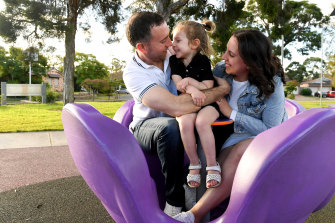Life-saving tests for newborns after Sydney study makes fatal condition treatable
The state government will permanently fund screening for a rare but devastating genetic disorder with a high infant death rate, after a study conducted in Sydney showed early therapy could turn diagnosis from a “heart-sink” to a treatable condition.
Of the 29 babies with spinal muscular atrophy (SMA) who took part in a global trial of a new gene therapy, including four treated at Sydney Children’s Hospital, all reached 18 months and the majority achieved their developmental milestones, such as sitting independently and walking.
Adam and Adriana Sharpe with their daughter Alessia, 3, who was the first baby to be diagnosed with SMA under the newborn screening program.Credit:Bianca De Marchi
SMA is the leading genetic cause of infant death. The condition, which occurs in one in 10,000 births, causes progressive muscle wastage. Without treatment, babies have a life expectancy of about nine months.
“Five years ago there was no therapy and, for the most common and severe form of SMA, the day you’d diagnose them was the best they’d ever be,” Associate Professor Michelle Farrar, who led the Sydney portion of the study, said. “It was a real heart-sink to diagnose those kids.”
Since 2018, a repeat lumbar puncture therapy has been available, also demonstrating good results. But Farrar said the shift from SMA being a condition that led to discussions about palliative care options to one treated through a one-off infusion therapy was “dramatic”.
“It is a major breakthrough to be able to transform a condition that’s lethal into something we are screening for free and treating,” she said, noting different treatment options would be appropriate for different babies.
The final results of the trial of the gene therapy, which is sold as Zolgensma and now listed on the Pharmaceutical Benefits Scheme, were published in Nature this month.
To facilitate the trial, the NSW government has funded newborn screening to recruit children with the condition early enough to take part.
Adriana and Adam Sharpe’s daughter, Alessia, was the first baby to be diagnosed with SMA under the newborn screening program, 17 days after it started in August 2018.
Qualifying for the gene therapy trial before she turned one month old, the now four-year-old learnt to crawl within normal a time frame, and now loves to ride her scooter and climb on play equipment.
“She’s not going to break the 10-second barrier in the 100 metres, but development-wise she’s fine – maybe a month or two behind physically,” Adam said.
Adriana said she and Adam were shocked to learn they were carriers but grateful for developments in treatment. The family are now expecting their second child.
After the success of the trial, all babies in NSW and the ACT will be offered free screening for SMA and another rare genetic disorder, Severe Combined Immunodeficiency Disorder (SCID), through a $1.3 million recurring funding promise by the NSW government.
SCID, which occurs in one in 40,000 births, causes a weakened immune system which can lead to lethal infection. Early stem cell treatment increases the survival rate to 94 per cent.
The tests will be provided to about 100,000 babies each year in their first three days of life as part of the existing “heel prick” bloodspot testing program.
“I urge other states and territories to screen newborns for both these genetic disorders as we are doing in NSW to give babies with SMA or SCID the best chance of survival,” Health Minister Brad Hazzard said.
Last week, Queensland announced it would be expanding its program to include SMA and SCID by May 2023. Victoria will add the conditions to its screening program over the next four years and Western Australia is conducting a trial.
Julie Cini, the CEO of Spinal Muscular Atrophy Australia who lost both of her daughters to the condition almost two decades ago, said the condition was no longer a death sentence with options including pre-pregnancy genetic testing on the table.
“That’s going to be life-changing for families. You used to have a diagnostic odyssey because it’s a rare condition not widely seen; diagnosis could take months,” she said. “But getting an answer within three weeks of life – that’s phenomenal, that’s saving lives.”
In need of some good news? The Greater Good newsletter delivers stories to your inbox to brighten your outlook. Sign up here.
Most Viewed in National
From our partners
Source: Read Full Article
